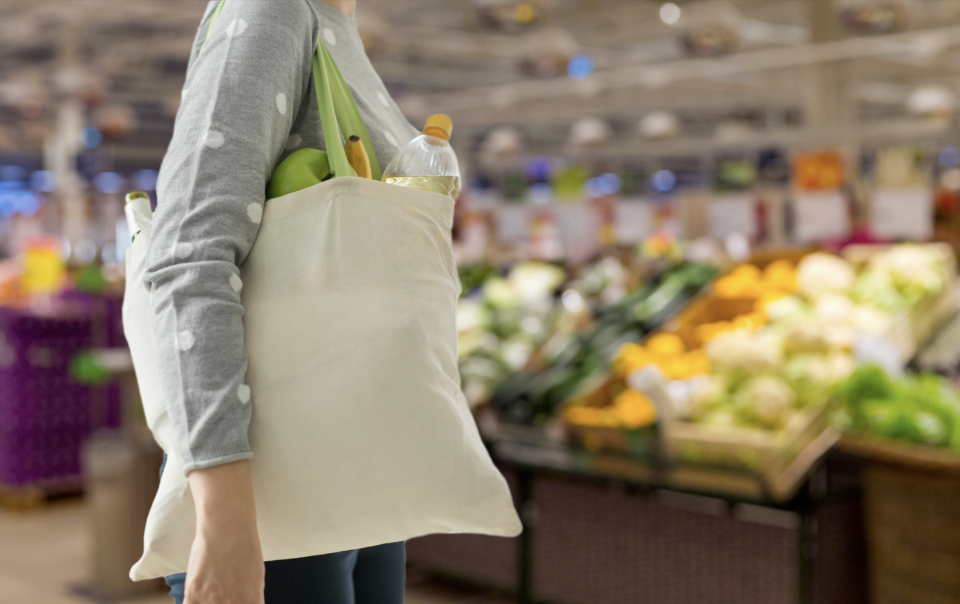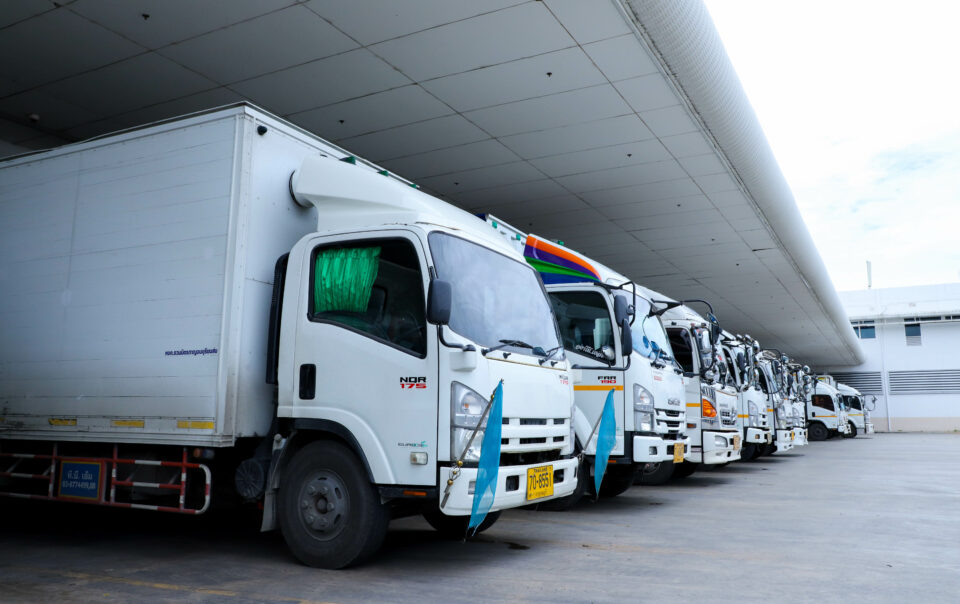
True Robotics ทีมนวัตกรชาวไทย ผู้ขับเคลื่อนเทคโนโลยีหุ่นยนต์ ภายใต้บริษัท True Corporation ซึ่งไม่เพียงนำหุ่นยนต์ ที่สร้างสรรค์ขึ้นไปใช้อำนวยความสะดวกแก่ผู้คน แต่ยังนำไปใช้ผลักดันความยั่งยืนให้สังคมในมิติต่างๆ ด้วย
แม้คำว่า “หุ่นยนต์” จะเพิ่งถูกบัญญัติขึ้นเมื่อหนึ่งร้อยปีที่แล้ว แต่ตลอดระยะเวลาร้อยปีที่ผ่านมา มนุษยชาติคิดค้นนวัตกรรมใหม่ๆ ได้มากมาย พลิกโฉมหน้าโลกของเราครั้งแล้วครั้งเล่า จนทุกวันนี้เทคโนโลยีหุ่นยนต์ก้าวหน้ามาไกล พวกมันมีฟังก์ชั่นหลากหลายและกลายเป็นส่วนหนึ่งในการใช้ชีวิตของทุกคนอย่างกลมกลืนไปแล้ว
ปัจจุบัน หุ่นยนต์เป็นตัวช่วยในภาคอุตสาหกรรม โรงงานสมัยใหม่แทบทุกโรงงานล้วนมีเครื่องมือจักรกลเป็นองค์ประกอบของสายพานการผลิต และการใช้งานในชีวิตประจำวัน เรามีตั้งแต่หุ่นยนต์ทำความสะอาด หุ่นยนต์เสิร์ฟอาหาร หุ่นยนต์ดูแลสนามหญ้า หุ่นยนต์คุณหมอประจำบ้าน หรือแม้แต่หุ่นยนต์สุนัข ก็เกิดขึ้นแล้ว
เราชวนคุณไปทำความรู้จัก True Robotics ทีมนวัตกรชาวไทย ผู้ขับเคลื่อนเทคโนโลยีหุ่นยนต์ ภายใต้บริษัท True Corporation โดยมี ดร.ธีระพล ถนอมศักดิ์ยุทธ หัวหน้าคณะผู้บริหารด้านนวัตกรรมและความยั่งยืน ที่มีวิสัยทัศน์ในการสร้างสรรค์นวัตกรรมมาตอบโจทย์โลกในอนาคต ต้องมองหาเทรนด์หรือเทคโนโลยีใหม่ ๆ ที่กำลังเข้ามาดิสรัปธุรกิจเดิม และให้สอดรับกับทิศทางของกลุ่มทรูที่กำลังปรับตัวสู่การเป็น “เทคคัมพานี” เป็นองค์กรดิจิทัลอย่างสมบูรณ์แบบ ซึ่งพวกเขาไม่เพียงนำหุ่นยนต์ที่สร้างสรรค์ขึ้นไปใช้อำนวยความสะดวกแก่ผู้คนเท่านั้น แต่ยังนำไปใช้ผลักดันความยั่งยืนให้สังคมในมิติต่างๆ โดยเฉพาะช่วงการแพร่ระบาดของโควิด-19 ที่ผ่านมา เจ้าหุ่นยนต์ได้เข้าไปมีบทบาทสำคัญในโรงพยาบาลหลายแห่งทั่วประเทศ
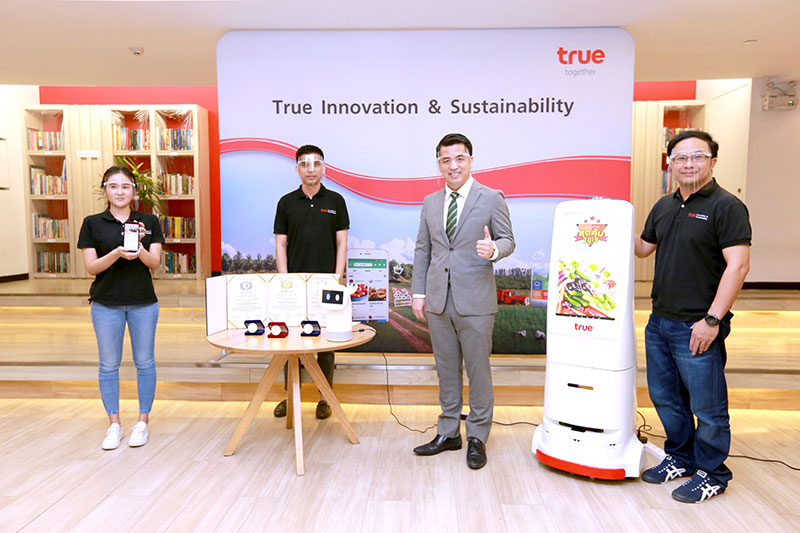
ทีมนวัตกรใช้ความสามารถสร้างความเปลี่ยนแปลงให้โลกดีขึ้นอย่างไร หุ่นยนต์ของพวกเขาหน้าตาเป็นแบบไหน และมีความเจ๋งยังไง คุณณพวรรษ ฉอ้อน นักพัฒนาหุ่นยนต์รุ่นใหม่ Senior Product Executive แห่ง True Robotics จะมาเป็นผู้พาทัวร์ห้องปฏิบัติการและบอกเล่าเรื่องราวให้เราฟัง

สร้างหุ่นยนต์ในบริบทคนไทย
True Robotics ก่อตั้งขึ้นด้วยเป้าหมายที่อยากจะพัฒนาหุ่นยนต์ที่เกิดจากฝีมือคนไทย โดยเฉพาะประเภทหุ่นยนต์บริการ (Service Robot) ที่จะมีประโยชน์ใช้สอยหลากหลาย ขึ้นอยู่กับการประยุกต์เทคโนโลยีไปใช้ โดยเริ่มจากการไปพาร์ทเนอร์กับบริษัทหุ่นยนต์ในต่างประเทศ
“ที่ผ่านมาประเทศไทยเป็นผู้ซื้อเทคโนโลยี รวมถึงหุ่นยนต์ต่าง ๆ ที่ต้องนำเข้ามา แต่ยุคนี้เป็นยุคที่ต้องเริ่มต้นคิดค้นผลงานนวัตกรรมที่เป็นของเราเอง เพื่อออกแบบให้ทำงานสอดคล้องกับวิถีชีวิตของคนไทยมากที่สุดจึงต้องมีการวิจัยและพัฒนาซอฟแวร์ และฮาร์ดแวร์หุ่นยนต์ที่เป็นของคนไทยขึ้นมา นอกจากการพัฒนาภายในองค์กรแล้ว กลุ่มทรู ยังใช้รูปแบบการจัดการนวัตกรรมแบบเปิด (Open Innovation) ร่วมมือกับมหาวิทยาลัยชั้นนำ 9 แห่ง ก่อตั้ง True Lab เพื่อสร้างระบบนิเวศ (Ecosystem) เป็นพื้นที่พัฒนาศักยภาพนักศึกษาผ่านกลไกการสนับสนุนทุนวิจัยและถ่ายทอดองค์ความรู้เพื่อเสริมทักษะความเป็นนวัตกรและที่เอื้อต่อการสร้างสรรค์นวัตกรรม สร้างผลงานวิจัยที่เป็นประโยชน์ต่อสังคมและประเทศไทย”
คุณณพวรรษ อธิบายว่า ซอฟแวร์ (Software) หมายถึง โปรแกรมหรือชุดคำสั่งที่ถูกเขียนขึ้น เพื่อสั่งการเจ้าหุ่นยนต์ เป็นสิ่งที่ฝังอยู่ภายในไม่สามารถสัมผัสได้โดยตรง ในขณะที่ฮาร์ดแวร์ (Hardware) คือชิ้นส่วนต่างๆ ที่ประกอบขึ้นเป็นหุ่นยนต์ มีโครงร่างที่มองเห็นและสัมผัสได้
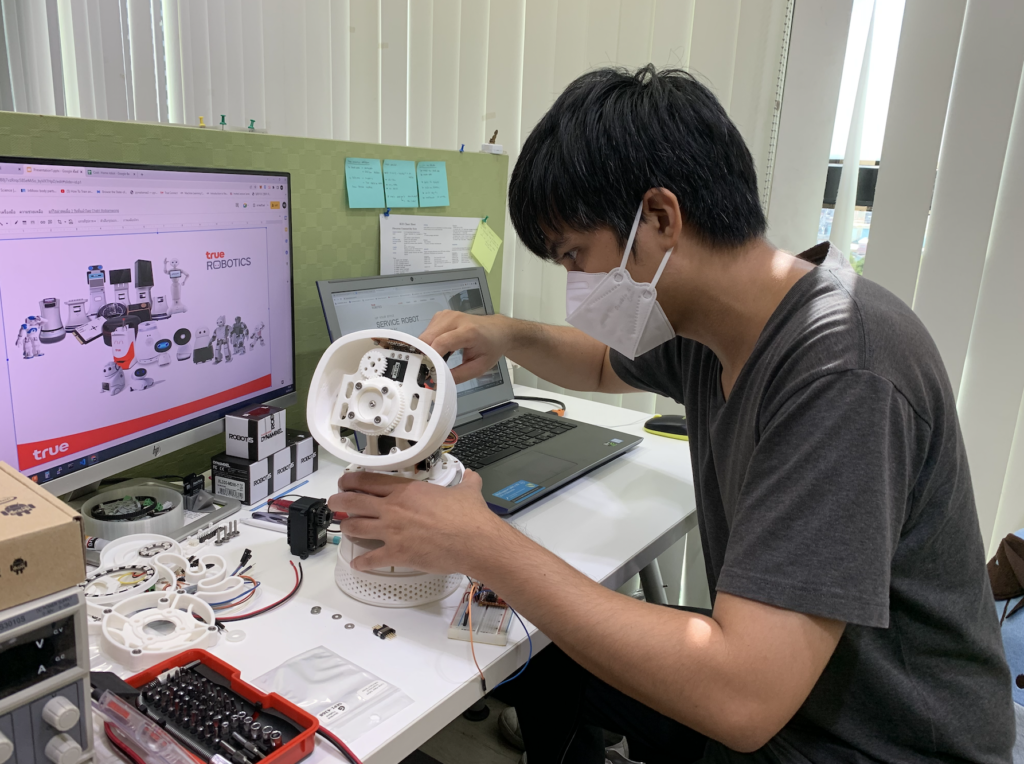
เปรียบเทียบให้เห็นภาพ ภารกิจของทีมงานก็คือ การ “ยกเครื่อง” เจ้าหุ่นยนต์ให้มีรูปลักษณ์ภายนอกและโปรแกรมภายใน ให้สอดคล้องกับการใช้งานในบริบทไทยๆ เหมาะสมกับคนไทย เพื่อเป็นโซลูชั่นแก้ปัญหาบางอย่างให้สังคมไทยนั่นเอง
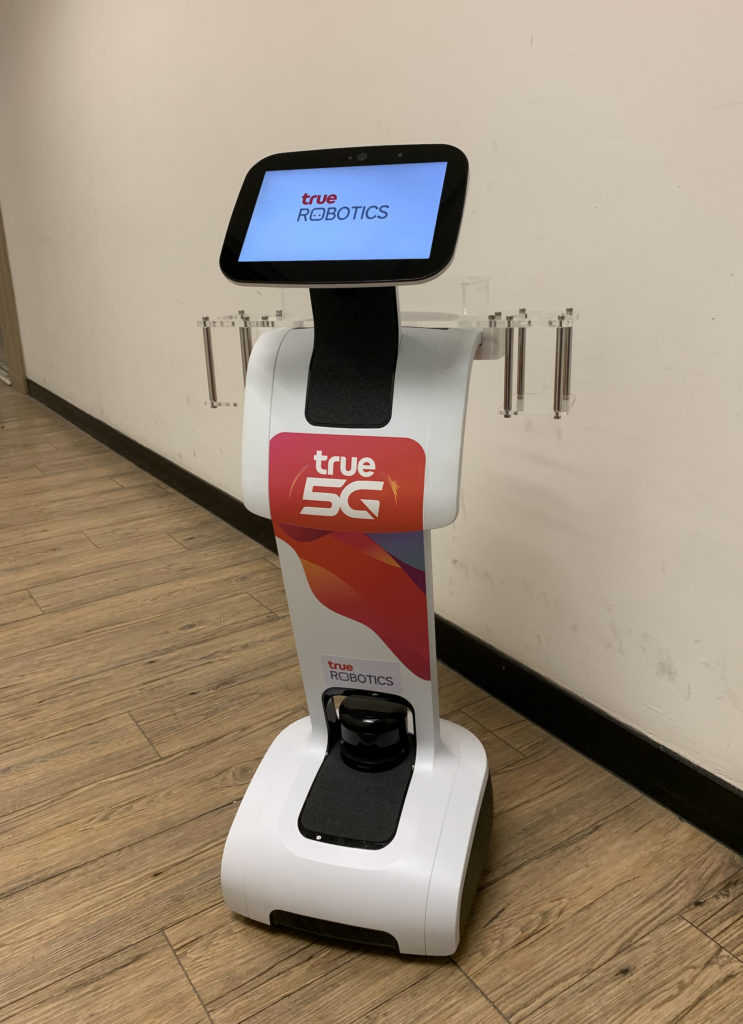
ความฉลาดที่มาพร้อมฟังก์ชั่น
หุ่นยนต์ที่เดินอย่างคล่องแคล่วมาทักทายเรามีชื่อว่าเทมิ (Temi Robot) ซึ่งเป็นหุ่นยนต์บริการเคลื่อนที่ ที่มีเซ็นเซอร์ และ LIDAR ซึ่งเป็นเทคโนโลยีตรวจจับและคาดคะเนระยะทางของวัตถุ ทำให้เทมิสามารถสร้างแผนที่สิ่งแวดล้อมรอบตัวได้อย่างแม่นยำ
“เมื่อเทมิเคลื่อนที่ได้ด้วยตัวเอง โดยไม่ต้องมีคนคอยควบคุม ตัวเขาจึงสามารถนำทางหรือขนส่งสิ่งของไปยังที่ๆ เราตั้งคำสั่งไว้ได้ เราจึงเห็นหุ่นยนต์ลักษณะนี้เป็นตัวช่วยในร้านอาหาร คอยนำอาหารไปเสิร์ฟยังโต๊ะต่างๆ ที่ถูกตั้งค่าไว้แบบแม่นเป๊ะ ไม่มีสับสน”
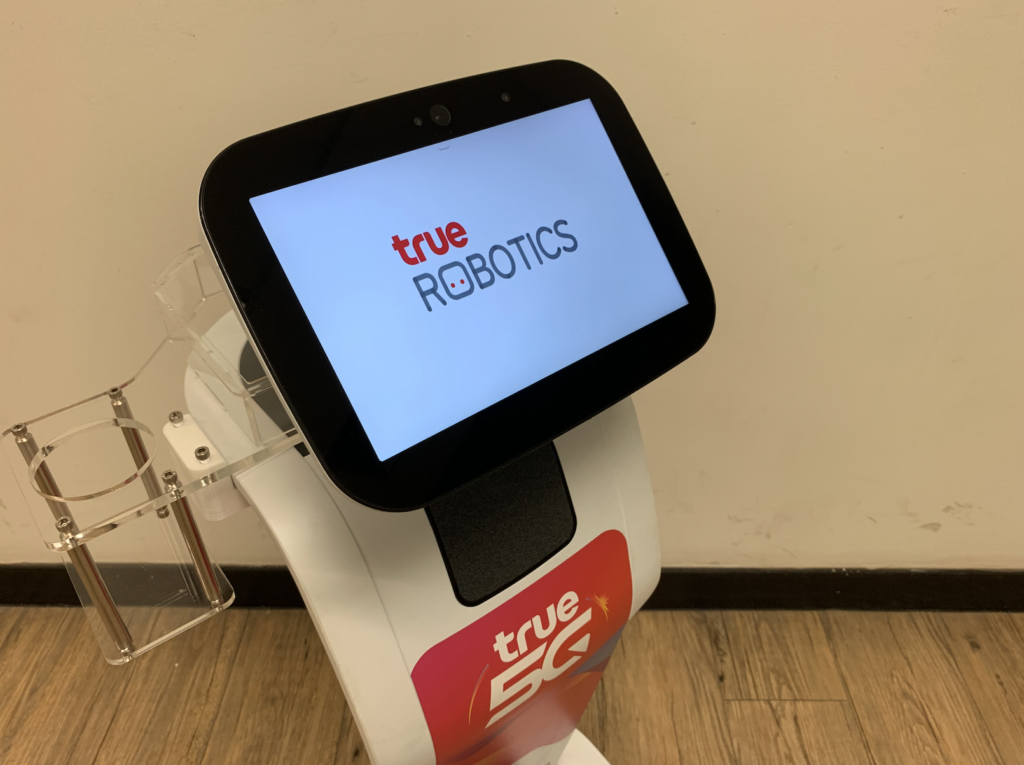
คุณณพวรรษอธิบายพร้อมชี้ให้ดูกล้องและจอภาพขนาดใหญ่สำหรับแสดงผลข้อมูลและตอบโต้กับมนุษย์ ซึ่งมีการติดตั้งระบบปฏิบัติการ Android ไว้ด้วย “ในส่วนของซอฟแวร์ ทีมนักพัฒนาของเรานำหุ่นยนต์เทมิมาอัพเกรดด้านการสื่อสารภาษาไทย รวมถึงติดตั้งอุปกรณ์รับสัญญาณ 5G สำหรับการใช้งานนอกสถานที่ ทำให้สามารถสื่อสารด้วยวิดีโอคอลได้เหมือนสมาร์ทโฟน
“ในส่วนของฮาร์ดแวร์ ผมได้ร่วมพัฒนาอุปกรณ์เสริมสำหรับติดตั้งเพิ่มบนตัวของเทมิ เพื่อให้มันมีฟังชั่นในการขนส่งสิ่งของมากขึ้น เราออกแบบถาด ตะกร้า กล่องที่มีขนาดพอดีกับบรรจุภัณฑ์ เพื่อเพิ่มความปลอดภัยในกรณีที่ต้องขนส่งสิ่งของที่บอบบางเป็นพิเศษอย่างเช่น ยาและเวชภัณฑ์”
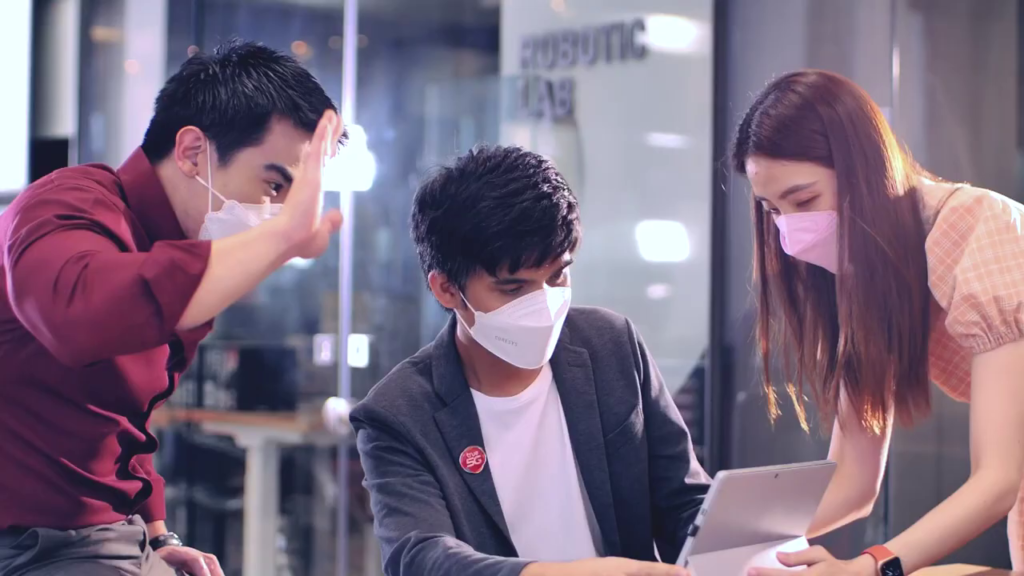
ปฏิบัติการหยุดเชื้อเพื่อชาติ
อาจแปลกตาไปสักหน่อย เมื่อเห็นหุ่นยนต์ล้อเลื่อนขับเคลื่อนอยู่ในโรงพยาบาล แต่นั่นคือสิ่งที่เกิดขึ้นในช่วง
การแพร่ระบาดของโควิด-19
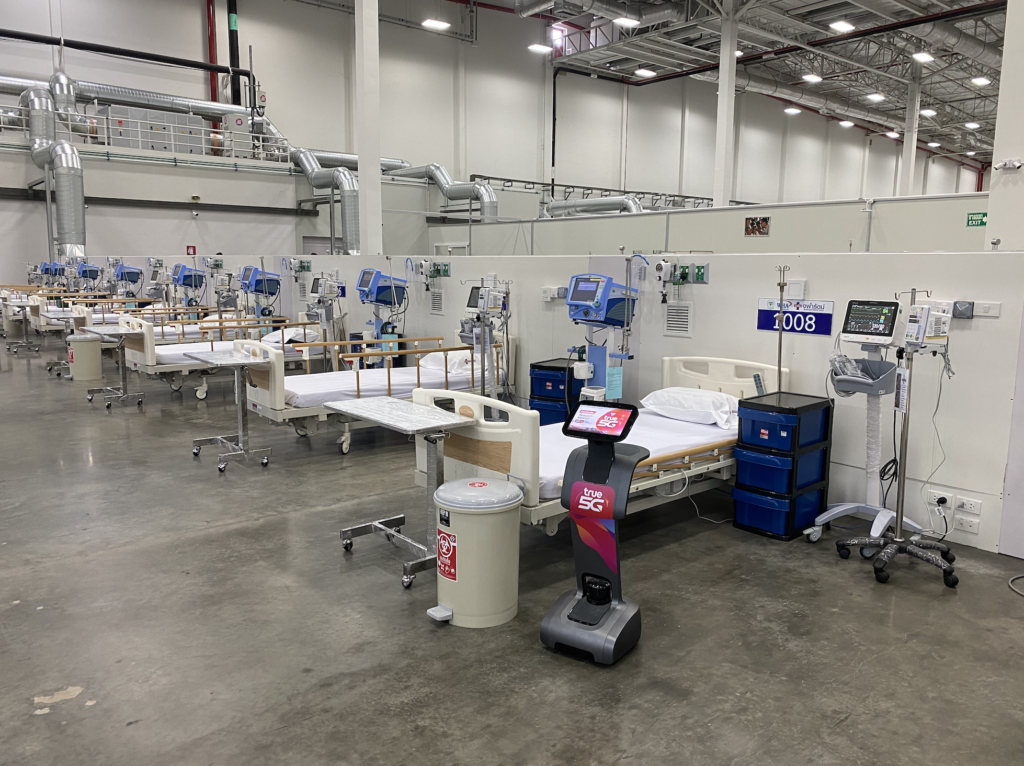
“อย่างที่ทราบกันดีถึงความเสี่ยงของบุคลากรการแพทย์ เมื่อต้องทำงานใกล้ชิดกับผู้ป่วยติดเชื้อที่กักตัวอยู่โดยตรง ทีมของเราตระหนักว่า เทมิน่าจะเข้าไปเป็นตัวช่วยลดความเสี่ยงตรงนี้ให้แพทย์และพยาบาลได้ จึงส่งเทมิเข้าไปเป็นลูกมือในโรงพยาบาลและสถานที่กักตัว คอยเดินส่งยา อาหาร และเวชภัณฑ์ต่างๆ โดยมีการพัฒนาอุปกรณ์เสริมที่ช่วยให้ขนส่งได้อย่างแน่นหนาปลอดภัย”
คุณณพวรรษเล่าว่า เริ่มแรกเทมิจะต้องเดินตามเจ้าหน้าที่ไปรอบๆ เพื่อให้เซ็นเซอร์ และ LIDAR วาดแผนผังห้องและเตียงผู้ป่วย จากนั้นเมื่อถึงเวลาปฏิบัติการจริง เจ้าหน้าที่สามารถเลือกคลิกจุดในแผนผังได้เลยว่า อยากให้เทมินำของไปส่งที่เตียงไหน มันจะเดินไปและกลับเองได้โดยไม่ต้องควบคุม หรือถ้าเจ้าหน้าที่ต้องการสั่งการแบบ Manual ผ่านสมาร์ทโฟนก็ได้เช่นกัน
อีกหนึ่งพื้นที่ปฏิบัติการของเทมิช่วงที่โควิด-19 ยังแพร่ระบาด คือในห้างสรรพสินค้าที่ผู้คนต้องออกมาจับจ่ายซื้อของด้วยความจำเป็น ทีม True Robotics จึงติดตั้งชุดอุปกรณ์เสริมสำหรับวัดอุณหภูมิ ให้เทมิวิ่งตรวจการและวัดอุณหภูมิผู้คนรอบๆ หากใครมีอุณหภูมิร่างกายสูงจะได้รีบดำเนินการขั้นต่อไปได้อย่างทันท่วงที
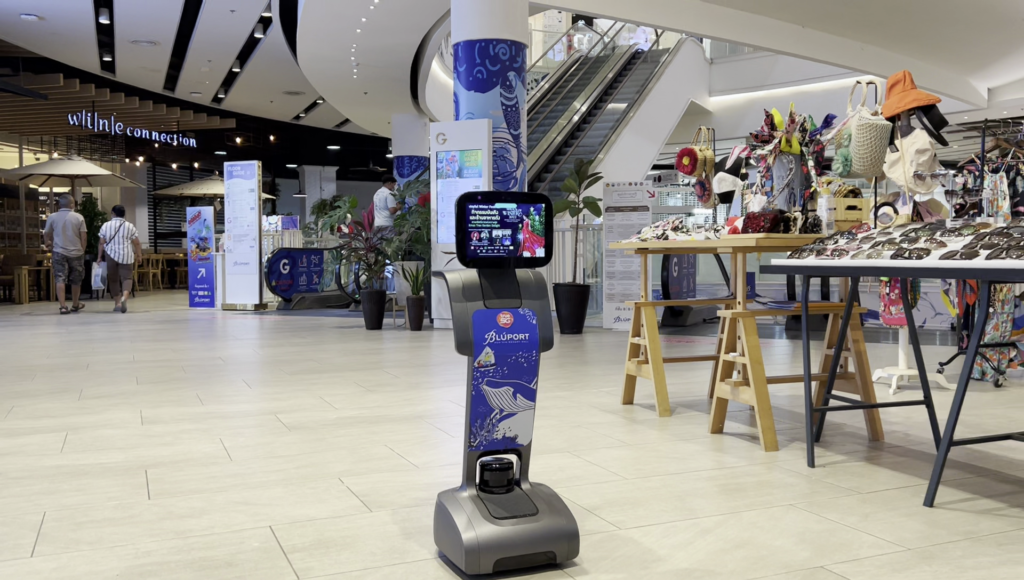
นักพัฒนาหุ่นยนต์ ผู้อยู่เบื้องหลังโลกแห่งอนาคต
นอกจากเทมิ ยังมีหุ่นยนต์ Homey ที่ทีมนักพัฒนาชาวไทยจาก True Robotics พัฒนาขึ้นเอง 100% เพื่อเป็นเพื่อนคู่บ้านคอยอัพเดตข่าวสาร และควบคุมอุปกรณ์ต่างๆ ของคนรุ่นใหม่ที่มักอาศัยอยู่คนเดียว และยังได้ร่วมมือกับหลากหลายพาร์ทเนอร์ เพื่อสร้างโลกอนาคตที่ยั่งยืนด้วยคนและเทคโนโลยี ไม่ว่าจะเป็นการยกระดับเมืองด้วยนวัตกรรม การนำเทคโนโลยีเข้ามาบริหารจัดการระบบการเกษตร การใช้เทคโนโลยี MR, AR และ VR และแพลตฟอร์มออนไลน์
ในแวดวงการศึกษา รวมไปถึง การยกระดับอุตสาหกรรม และร้านค้าปลีกอัจฉริยะ ด้วยระบบจัดการร้านค้ายุคใหม่แบบผสมผสานเทคโนโลยีในด้านต่าง ๆ ทั้ง AI และ Analytic และที่สำคัญ คือ การยกระดับคุณภาพชีวิตของผู้คนด้านสุขภาพและความเป็นอยู่ที่ดี (Health & Wellness) ด้วยเทคโนโลยี
ในวันนี้ เราจึงเห็นได้ชัดเจนว่า หุ่นยนต์อยู่ในชีวิตประจำวันของเราแล้วจริงๆ ข้าวของเครื่องใช้ล้วนผลิตในโรงงานที่ใช้หุ่นยนต์ ตัวช่วยของทุกคนตั้งแต่ที่บ้าน ที่ทำงาน ร้านค้า ไปจนถึงโรงพยาบาลก็ล้วนมีหุ่นยนต์เป็นลูกมือทั้งสิ้น
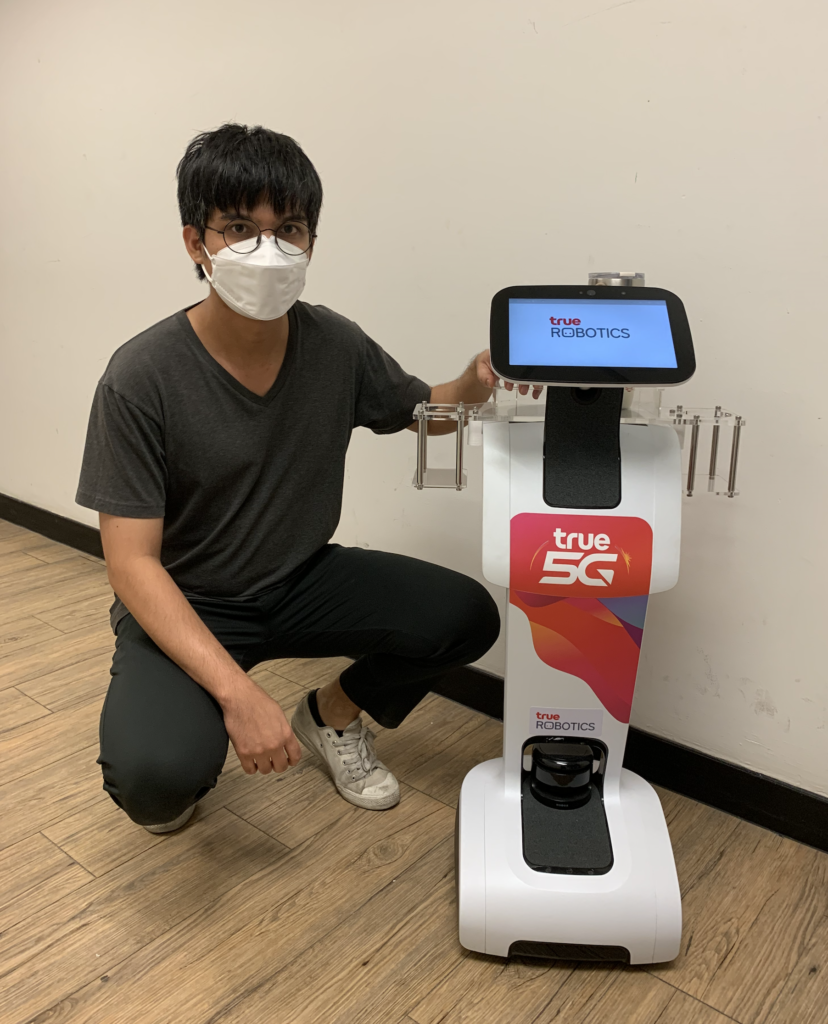
“ในมุมมองของนักพัฒนาหุ่นยนต์ แน่นอนครับว่าเราย่อมรู้สึกภูมิใจ เมื่อของที่เราประดิษฐ์คิดค้นขึ้นนั้นมีประโยชน์ต่อผู้คน ทำให้มนุษย์ใช้ชีวิตง่ายขึ้น และช่วยแก้ปัญหาสังคมบางอย่าง ทุกคนมีความเชี่ยวชาญเฉพาะตัวที่แตกต่างกัน สำหรับพวกผม ทีมของเรากับการทำหุ่นยนต์ คือสิ่งที่เราถนัด และเราขอใช้จุดแข็งนี้สร้างความยั่งยืนให้สังคมและผู้คน”
เราปรับ โลกเปลี่ยน The Next Generation: เทคโนโลยีหุ่นยนต์ ยกระดับชีวิตยั่งยืน
หรือ จะเลือกรับฟังรายการ ในรูปแบบของ Podcast ได้ที่:
เราปรับ โลกเปลี่ยน The Next Generation เพราะเราทุกคน ”เปลี่ยน” โลกให้ดีขึ้นได้ พบหลาก idea หลาย action ของคนรุ่นใหม่ที่ลุกขึ้นมา “ปรับ” คิดแล้วลงมือทำ เพื่อร่วมกันสร้างโลกให้ยั่งยืน
WeShiftWorldChange #NextGeneration #เราปรับโลกเปลี่ยน #ทุกคนเปลี่ยนโลกให้ดีขึ้นได้

